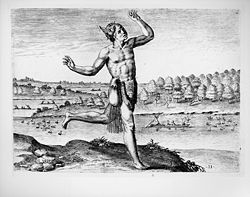- Shamanism among the indigenous peoples of the Americas
-
Further information: Native American mythology and Native American religion
The numerous indigenous peoples of the Americas held manifold beliefs in magic, in western ethnology sometimes described as shamanism, sorcery or witchcraft.[dubious ]
Contents
North America
Navajo medicine men, known as "Hatałii", use several methods to diagnose the patient's ailments. These may include using special tools such as crystal rocks, and abilities such as hand-trembling and trances, sometimes accompanied by chanting.
South America
Among the Mapuche people of South America, the community "shaman", usually a woman, is known as the Machi, and serves the community by performing ceremonies to cure diseases, ward off evil, influence the weather and harvest, and by practicing other forms of healing such as herbalism.
In the Peruvian Amazon Basin and north coastal regions of the country, the healer shamans are known as curanderos. In addition to Peruvian shaman’s (curanderos) use of rattles, and their ritualized ingestion of mescaline-bearing San Pedro cactuses (Trichocereus pachanoi) for the divinization and diagnosis of sorcery, north-coastal shamans are famous throughout the region for their intricately complex and symbolically dense healing altars called mesas (tables). Sharon (1993) has argued that the mesas symbolize the dualistic ideology underpinning the practice and experience of north-coastal shamanism.[1] For Sharon, the mesas are the, "physical embodiment of the supernatural opposition between benevolent and malevolent energies” (Dean 1998:61).[2]
In the Amazon Rainforest, at several Indian groups the shaman acts also as a manager of scarce ecological resources.[3]). The rich symbolism behind Tukano shamanism has been documented in some in-depth field works[4][5][6] even in the last decades of the 20th century.
Both Selk'nam and Yámana had persons filling in shaman-like roles among the Fuegians. The Selk'nams believed their [xon]s to have supernatural capabilities, e.g. to control weather.[7][8] The figure of [xon] appeared in myths, too.[9] The Yámana [jekamuʃ][10] corresponds to the Selknam [xon].[11]
References
- ^ Joralemen, D and D Sharon 1993 Sorcery and Shamanism: Curanderos and Clients in Northern Peru. Salt Lake City: University of Utah Press.
- ^ Dean, Bartholomew 1998 “Review of Sorcery and Shamanism: Curanderos and Clients in Northern Peru” American Ethnologist. 25(1): 61-62.
- ^ Gerardo Reichel-Dolmatoff: A View from the Headwaters. The Ecologist, Vol. 29 No. 4, July 1999.
- ^ Christine Hugh-Jones: From the Milk River: Spatial and Temporal Processes in Northwest Amazonia (Cambridge Studies in Social and Cultural Anthropology). Cambridge University Press, 1980.
- ^ Stephen Hugh-Jones: The Palm and the Pleiades / Initiation and Cosmology in Northwest Amazonia (Cambridge Studies in Social and Cultural Anthropology). Cambridge University Press, 1980.
- ^ Reichel-Dolmatoff, Gerardo (1997). Rainforest Shamans: Essays on the Tukano Indians of the Northwest Amazon. Dartington: Themis Books. ISBN 0-9527302-4-3.
- ^ Gusinde 1966:175
- ^ About the Ona Indian Culture in Tierra del Fuego
- ^ Gusinde 1966:15
- ^ Gusinde 1966:156
- ^ Gusinde 1966:186
See also
Categories:- Shamanism of the Americas
- Mythology of the Americas
Wikimedia Foundation. 2010.

